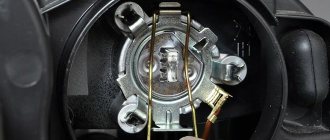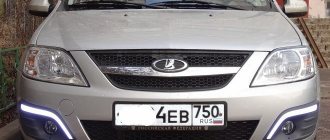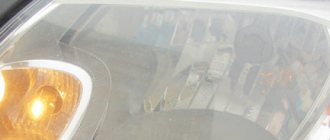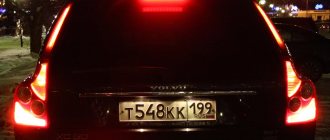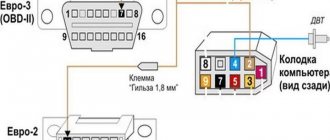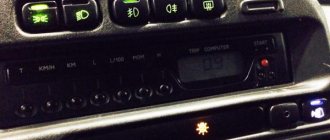On the territory of the Russian Federation, amendments to the rules of the road (TRAF) have been in force for more than 8 years, according to which a moving vehicle during daylight hours must be indicated by low beam headlights, fog lights (FTL) or daytime running lights (DRL). Using headlights and fog lights for these purposes has a number of disadvantages. Therefore, drivers prefer to buy ready-made running light modules and install them in their cars themselves. How to properly connect daytime running lights so that their operation is safe and does not contradict current laws?
Does it make sense to install DRLs into standard car headlights yourself?
New traffic rules oblige drivers to operate vehicles during the daytime with low beam lights or daytime running lights turned on. The latter, of course, is preferable, but, unfortunately, this option is only available in cars released relatively recently. This is where all sorts of handmade ideas arise, especially since their advantages are quite objective:
- Organizing DRLs from the main beam with your own hands only requires modification in the form of connecting an electronic relay.
- Self-tuning is much cheaper than purchasing branded lighting fixtures.
- Extending lamp life.
- Reducing the load on the generator and saving fuel.
Let's not forget about the practical benefits - the car immediately becomes more noticeable, this is especially important when driving against the sun. Some lazy car enthusiasts may argue that low-beam headlights are quite suitable for the role of running lights, except that the dimensions and license plate lights will be on. And, you know, if we keep in mind the owners of “stale” models, then such thoughts are in a sense natural.
What are the rules for installing and connecting DRLs in Russia: is it possible to do this yourself?
The Ministry of Internal Affairs of the Russian Federation has such a document as the appendix of the Procedure for controlling changes to the design of a vehicle. It regulates a list of changes that do not require a conclusion, that is, they can be carried out without the permission of an authorized organization. It should be immediately noted that equipping the vehicle with running lights is not included in this list.
Thus, the rules for installing DRLs in Russia require installation of equipment only in standard locations. If there are none, then you will have to obtain permission for reconstruction. For example, the owner of a VAZ 2106 is advised to turn on the low beam, but if he installs daytime lights himself, he breaks the law. The situation is reminiscent of a violation of glass tinting standards and can lead to punishment, including deprivation of rights.
How to obtain permission for reconstruction?
In order not to break the law, you need to go to the traffic police, where a base has been created for installing daytime lighting on almost all car models. It is worth considering that when choosing lighting devices on your own, traffic police officers will measure the level of their luminous flux.
In the case where the DRL is supplied even in accordance with the standards, without permission this will be considered as unauthorized interference with the design of the car. In addition, the law combats such violations as underbody lighting, equalizer on the glass and other lighting equipment that imitates a special signal.
QUESTION ANSWER
— How to choose the best form of DRL?
Generally speaking, this is a matter of taste. But we must keep in mind the requirement of GOST 41.87–99: the total area of the luminous surface of the DRL must be at least 40 cm². For rectangular lanterns it is easy to measure it with a ruler, but round ones should have a diameter of at least 50 mm.
Let's offer a couple of simplest solutions. In the case of low-power DRLs, you can get by with just one diode, see diagram 1:
For higher-current flashlights, pay attention to diagram 2: you will need only one additional automotive relay with normally closed contacts. In any case, the craftsman’s task is to find in the on-board network a wire that is supplied with power when the ignition is turned on, and another one that goes to the headlight or low beam bulb
If you purchased a product with an electronic unit, you only need to make a tap from the light bulb. And connect the remaining two wires directly to the battery terminals. Do not confuse the polarity - it is indicated in the instructions.
- Which case is better - metal or plastic?
DRL housings are made of either aluminum alloy or plastic. So they won't rust. But there is one subtlety: although LEDs have high efficiency, they heat up quite strongly, and overheating sharply reduces their service life. Therefore, you need a good heat sink, and not a “thermos” with a plastic shell. Of course, if the current consumed is small - say, tens of milliamps - then there is practically nothing to dissipate. But truly bright DRLs already consume many hundreds of milliamps, so a plastic casing is unacceptable for them. However, manufacturers know about this. And if they offer plastic, then there is nothing to count on the luminous intensity corresponding to GOST. Most likely, it's just a beautiful trinket with lights.
— Will traffic police inspectors find fault with self-installed DRLs?
The question is not easy. On the one hand, the traffic rules directly state that it is inadmissible to drive with DRLs instead of low beam headlights. Another document, the regulations, just as directly prohibits making any changes to the car’s lighting equipment. But we are not replacing standard headlights with something else, we are just adding a new set. In general, the situation is ambiguous.
— Where and how to properly attach the DRLs?
There are clear standards in this regard in GOST R 41.48–2004, and in accordance with them you will have to choose a location. Most likely, you will install it in the bumper or in the grooves of the radiator grille. Different DRLs are attached in different ways, so first figure out where they can be placed.
So, the outer edge of the DRLs should be positioned no further than 400mm from the edge of the car, and there should be a minimum of 600mm between the inner edges of the two DRLs (400mm if your car is less than 1300mm wide). The installation height of the DRL above the ground is set very freely: from 250 to 1500 mm, that is, you can also screw it onto the hood. But not at the windshield - there should be no visible reflections from the same hood!
— How to measure the intensity of light?
To accurately measure light intensity, special and rather expensive equipment is required. But you can approximately estimate it using a regular lux meter. To do this, you need to measure the illumination of the surface at a certain distance from a light source of known strength and then repeat the same for the devices under test. This illumination is proportional to the intensity of light. In our case, this approach is justified: all DRLs were divided into two groups: in one, the light intensity complies with GOST standards with a margin, in the other, with an even larger “margin,” it falls short of it.
Popular options for organizing daylighting in a car
After reading all of the above, some motorists may be upset. But in vain - there is a way out of this situation, because it is not necessary to use branded LED headlights. Light sources that you can install yourself, taking into account the technical tolerances of a certain car design, are quite suitable. There are many electrical circuits with which the system will be activated, including connection from a generator - everyone chooses their own option.
For example, you can make DRLs into standard headlights with your own hands from fog lights or at the place where their installation is planned. You don’t need permission to do this, all you have to do is connect the system as follows:
- When you turn the ignition key, the running lights turn on automatically.
- When the headlights are turned on, the running lights turn on, except in cases where the headlights are turned on briefly.
Low beam or dimensions
You can also connect to the side lights or low beam headlights. In theory, everything here also looks quite simple, interesting and promising. The first of the schemes under consideration provides that you will use an electrical circuit that powers the size lamps. Here the plus from the DRL is connected directly to the battery as a power source. But the minus goes to the plus of the dimensions. At such a moment the latter will be electrically neutral. Thus, the current flows from the plus of the battery through the diodes to the dimensions, and then through the lamp to the housing, where the latter acts as a minus of the created electrical circuit.
Since the level of current consumption will be small, the diodes will start to work, but the size lamp will not turn on.
As soon as the driver switches to the dimensions, a voltage of 12V will appear on its positive side, the potentials will be equalized on the DRL wiring and the diodes will go out. The circuit will begin to operate in normal mode, supplying current to the dimensions.
Everything seems to be fine. But again, conclusions were drawn hastily.
The scheme is simple and working. It just has a few drawbacks:
- The drive trains will remain active when the engine is switched off. This directly contradicts current laws;
- If the dimensions are equipped with LED lamps, such a circuit will immediately become inoperative;
- Operation will not be correct when using powerful SMD diodes as part of DRLs;
- To provide additional safety, you will have to add a fuse to the circuit.
To avoid the first drawback, the circuit is slightly altered. The positive from the LED module is taken not from the positive of the battery, but through the positive of the ignition switch.
The second scheme involves activating the DRL using a low beam lamp. The point is that when the low beam is turned on, the walkers are turned off, and the rest of the time they work.
There are the same disadvantages here as for the previous scheme. That is, it contradicts GOST and traffic rules.
How to make DRLs on a Priora with your own hands from high beam headlights using a relay?
the DRL-30 electronic makes it possible to turn on the high-beam lamps at only 30% of their full power. This is enough to use them as running lights. They turn on when the ignition is on, the lights are off and the handbrake is released. The relay is installed in place of the standard microprocessor device and connected using the following technology:
- Disconnect the ground terminal from the battery.
- Open the cover of the relay block, remove the high beam relay K7 and install DRL 30 in its place.
- Unscrew the screws securing the instrument panel frame and remove the instrument cluster by pressing the latch.
- Route the relay wires under the panel so that the ends are level with the instrument connector.
- Connect the wires using connecting elements according to the diagram.
- Connect the connector and ground terminal of the battery.
After completing the work, you should check the operation of the electronic relay in the following sequence:
- Turn on the ignition and put the car on the handbrake - the lamps should not light up.
- Release the handbrake lever - the indication and high-beam lamps should light up at full intensity (30%).
- Blink the high beams - the lamps should light up at full power, and then return to 30%.
- Turn on the headlights - the lights should go out.
- Turn on the high beams - the lamps should be on 100%.
- Turn off the ignition - the lamps should go out.
If the lights burn at full power immediately after connecting the ground, you need to swap terminals 30 and 87 in the mounting block.
Upgrading standard lights using an electronic relay eliminates the unnecessary hassle of installing additional lamps. In addition, the load on the generator is reduced and the operational life of the lighting devices is extended. If necessary, you can easily return to the stock connection.
Purchasing and installing daytime running lights is a serious task for a car owner. These lighting devices are designed to improve the visibility of the vehicle during the daytime and prevent emergency situations. However, many of our compatriots have virtually no information about daytime running lights equipped with a turn signal function. They do not understand how to choose such models correctly. They don’t know if it’s possible to cut flexible DRLs. Poor understanding of installation intricacies. That is why, before making a purchase, it is important to collect as much useful information as possible about the devices, analyze them and use them wisely.
Where can I buy?
According to reviews, the most convenient way to order flexible DRLs for Lada X-Ray is via the Internet. If timing is not important for you, then it is better to make a purchase on Aliexpress, since the products on this site are cheaper. The price varies between 400-600 rubles. The only negative is the long delivery time, which usually ranges from 2 to 4 weeks.
The price depends on the length of the tape itself. For a domestic hatchback, there is no point in buying products 60 cm in length - 2 tapes of 45 cm and 2 of 35 cm will be enough.
On Russian sites the cost of products is higher:
How to choose flexible daytime running lights
Regardless of whether you are interested in installing lights with or without a turn signal function, it is important to give preference to quality models. They must be powerful and bright enough, well sealed, and have an effective cooling system.
In addition, car owners who are interested in how to choose flexible daytime running lights should take into account that they come standard and universal. Lighting devices of the first type are designed for installation on certain vehicle models. And universal DRLs equipped with a turn signal function have a wider scope of application.
Depending on the features of the device, you can choose modular cluster daytime running lights and strips enclosed in silicone tubes. In any case, the design will include two types of LEDs - white (working as DRLs) and yellow (playing the role of turn signals). This makes the models under consideration as universal as possible. Moreover, you can buy flexible DRLs with a turn signal function, in which white and yellow LEDs work alternately or simultaneously. In the first case, the daytime running lights will turn off when the car's course changes, so that the turn signals come on instead. In the second, during rotation, both types of LEDs will function simultaneously. You can choose any option - products in each category are easy to install and easy to use.
Installation of flexible DRLs with turn signal function
Even before making a purchase, it is important to figure out how to attach flexible DRLs to the headlight. A car owner who has chosen modern daytime running lights can cope with this task on his own. Their installation is not difficult. The main thing is to act step by step:
1. Disconnect and dismantle the headlight, and then carefully disassemble it. To install flexible DRLs with a turn signal function, you need to open the product body, separating the optical part from the plastic box. Use a hair dryer to heat the sealant and rubber gasket that connects the glass and headlight housing, loosening them. Otherwise, you may damage the product during disassembly.
2. Next, you need to think about how to attach flexible DRLs to the headlight. Regardless of whether you choose a cluster or another model, the daytime running lights will be mounted on the inner surface of the headlight.
3. Another important step is assembling the electrical circuit, thanks to which the lighting devices will perform their functions. There are many connection options involving the use of a control unit, relay or toggle switch. You need to choose the most suitable one.
According to this scheme, flexible daytime running lights with a turn signal function are always installed in the headlights of a car. At the same time, you can cut products and shorten them to the required length. The main thing is to choose the right lighting devices, as well as act carefully and strictly follow the recommendations of specialists.
Daytime running lights in many countries today are mandatory optics that must be turned on during the daytime. Because of this, many car owners are faced with the need to purchase and install DRLs in their cars. But there were also those who decided to make DRLs into standard headlights with their own hands. You can learn more about the manufacture and connection of this type of optics from this material.
Legal norms in Russia and Ukraine
Manufacturing instructions
Tools and materials
Installation diagram for running lights
Photo gallery “Connection diagrams”
How to connect DRLs yourself?
Video “Option for connecting running lights without using a relay”
Comments and Reviews
LED neon tube
Two-color flexible tube
If you correctly install the flexible tape or tube inside the headlight, you will get decorative lighting that will look decent. You won't get DRLs from such a tube, even if you try hard.
The most difficult installation option, you will have to disassemble the headlight. The hardest part is removing the clear plastic from the front. The headlight is sealed and the glass is sealed. There are two types of sealant: one that softens at temperatures above 100 degrees, and one that does not soften at all even at 300 degrees. I came across non-separable ones, one took 10 hours to disassemble so as not to spoil or scratch it. I tested the sealant with a soldering iron, which heated up to 300° and could not melt it.
Bake until done and sprinkle with stewed nails
For heating, use an oven or box heated with a hair dryer. Once the sealant softens, the clear plastic will come off easily. For reassembly, you can buy a special rubber sealant, which is used by xenon technicians.
Legal norms in Russia and Ukraine
In principle, building daytime running lights with your own hands is not a particularly difficult task. To do this, you only need steady hands and minimal knowledge in the field of electronics. However, before you make running lights for your car, you need to know exactly what the letter of the law says on this matter. Otherwise, you may encounter problems with improper installation, which will lead to fines and regular stops by police officers.
According to the laws of the Russian Federation, running lights on a car must be turned on in any case, regardless of the time of year or day. This rule was introduced back in 2011. The DRLs themselves can be used in conjunction with low beam headlights, as well as fog optics. But if it is not possible to connect them to the existing optics, then they can be installed separately from the headlights. The main thing is that the installation is carried out taking into account all requirements and standards.
Standards for installing running lights
As for Ukrainian legislation, the traffic rules indicate that DRLs in headlights are lighting devices.
But unlike Russian legislation, in Ukraine the need to turn on daytime running lights arises in several cases:
- during the period from October 1 to May 1 at any time of the day;
- when driving in low visibility conditions;
- when driving outside populated areas.
What LED strips are there for cars?
Of course, they can be divided according to the light of the glow: red, blue, yellow, green, etc. You saw our color recommendations above. Let's dwell on what kind of lamps generally exist and their features.
- Each lamp is in a separate silicone cylinder.
- Sealed LED strip SMD 5050, mounted only on the bottom side.
- Tape placed in a PVC tube.
Remember, the tape must be waterproof. Choose only those that have protection IP 65 and IP 68. If the tape is installed directly into the headlight, then you can choose less protection.
Manufacturing instructions
So, if you decide to install DRLs in standard headlights yourself, then you do not have to trust the installation process to specialists. Of course, if you have never encountered such a task before, it is better to trust a qualified electrician. The process of making DRLs with your own hands is described in detail below.
Tools and materials
In principle, it is possible to make DRLs from high beams, but we will look at the manufacturing process using the example of using fog lamp housings.
How to connect DRLs yourself?
To connect homemade DRLs, follow these steps:
- To ensure activation of optics with ignition, thyristors can be used, and the current in them should be 0.3 amperes. Thyristors with a resistance of 10 kOhm should be used, and their power will be 0.25 volts.
- The zero contact is disconnected from the relay winding. If your car has electric windows, then this contact will be responsible for their operation. The dismantled connector must be well insulated to prevent short circuits in the future.
- Then the PTF enable contact is connected to the DRL relay. This circuit must be built into the relay, which is located in the block.
- If no errors were made during the connection process, the running lights will be activated when the ignition is turned on. If something doesn't work, check the circuit again.
Switching on through dimensions or low beam
The second version of the DRL connection diagram involves using the power circuit of the side light bulb. To do this, the positive wire from the running lights is directly connected to the “+” from the battery. In turn, the negative wire is connected to the “+” of the side light, which is currently electrically neutral. As a result, the following current flow path is formed: from the “+” of the battery through the LEDs to the size, and then through the light bulb to the body, which serves as the minus of the entire circuit. Due to the low current consumption (tens of mA), the LEDs begin to glow, and the lamp spiral remains extinguished.
This circuit solution has several disadvantages:
- running lights remain on when the engine is turned off, which is contrary to current regulations;
- the circuit will not work if LEDs are also installed in the dimensions;
- the circuit will not work correctly if the DRLs contain powerful SMD LEDs, the rated current of which is comparable to the current of a light bulb;
- For safety reasons, an additional fuse must be installed.
This connection method can be improved by connecting the positive wire of the LED module not to the “+” of the battery, but to the “+” of the ignition switch, thereby eliminating the first drawback.
